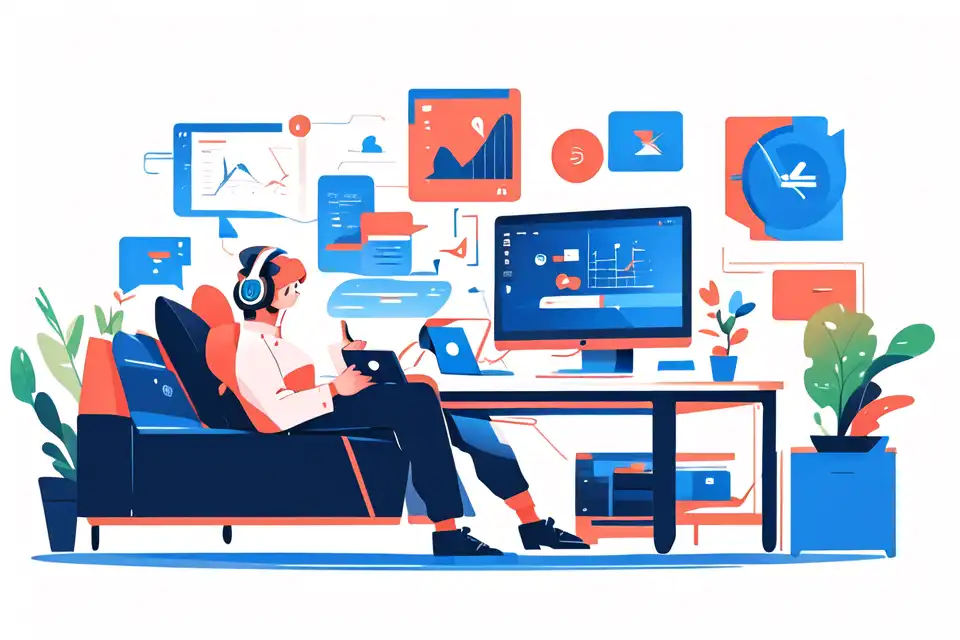Content Marketing And Buyer'S Journey
Learn about the top tips and strategies in content marketing and buyer's journey.
Try Lark for Free
In an era where digital technology is at the forefront of business operations, understanding and effectively utilizing content marketing and the buyer's journey has become paramount. This article aims to delve into these pivotal aspects of digital marketing, providing readers with a broad overview and detailed insights into their application in the business landscape. We will tackle everything from their definitions and significance to their role in shaping digital strategies, benefits to businesses, implementation techniques, and future trends.
"Unlock the power of Lark to elevate your business operations. Discover actionable strategies and best practices in our comprehensive guide."
Understanding content marketing and the buyer's journey
Defining Content Marketing and the Buyer's Journey
Content marketing, at its core, is a strategic marketing approach that focuses on creating, distributing and amplifying valuable, relevant, and consistent content. This content, crafted meticulously, aims to attract and engage a well-defined audience, ultimately driving profitable customer action.
On the other hand, the buyer's journey refers to the process that consumers go through before making a purchase. This process typically includes three stages: awareness, consideration, and decision. Understanding this journey is essential in creating effective content that resonates and influences consumer behavior.
Significance in the Marketing Ecosystem
Content marketing and the buyer's journey play a crucial role in the marketing ecosystem. Content marketing builds trust and fosters relationships with potential customers by providing them with valuable information. It influences the buyer's journey by guiding consumers through the different stages, helping them make informed decisions.
Indeed, a well-strategized content marketing plan can shape customer perceptions, enhance brand reputation, and ultimately drive sales. A study by the Content Marketing Institute revealed that 72% of marketers say content marketing increases engagement and leads.
The role of content marketing and the buyer's journey
Influence on Digital Strategies and Customer Engagement
Content marketing and understanding the buyer's journey have a profound effect on forming digital strategies. By creating engaging content that aligns with the stages of the buyer's journey, businesses can guide consumers towards making a purchase.
For example, during the awareness stage, educational content like blog posts and e-books can be used to introduce the brand. As the consumer moves to the consideration stage, in-depth content like case studies or webinars can be utilized. Finally, during the decision stage, businesses can use persuasive content like testimonials or product comparisons to motivate a purchase.
Benefits for Organizations and Professionals
Companies that invest in content marketing and understand the buyer's journey stand to reap numerous benefits. These include improved brand awareness, increased customer loyalty, and increased leads and conversions. For marketing professionals, understanding these concepts can aid in creating more effective marketing strategies and campaigns.
Learn more about Lark can help you with everything mentioned in the article.
Implementing content marketing and buyer's journey strategies
Integrating into Digital Marketing Plans
Successful integration of content marketing and the buyer's journey into a digital marketing strategy requires a clear understanding of the target audience, their needs, and their online behavior. The first step is to create buyer personas, representing your ideal customers. Next, map out the buyer's journey for each persona, identifying the key touchpoints where your content can influence their decisions. Then, create and distribute content tailored to each stage of the journey.
Best Practices and Methodologies
Creating effective content requires understanding what resonates with your audience. This involves thorough keyword research, using engaging and persuasive language, and including compelling calls-to-action. Also, maintaining consistency in brand voice and style across all content helps improve brand recognition.
Understanding the buyer's journey requires conducting customer surveys, analyzing customer data, and mapping out customer touchpoints. This enables businesses to identify key opportunities and challenges in the journey and devise strategies accordingly.
Technological considerations for content marketing and the buyer's journey
Tools, Platforms, and Technologies
Several tools and platforms can aid in content marketing and understanding the buyer's journey. These include content management systems, SEO tools, social media management tools, analytics platforms, and customer relationship management (CRM) systems. These tools provide valuable insights into customer behavior, trends, and preferences, enabling businesses to create more effective content and strategies.
Integrating with Existing Systems and Analytics
To maximize the benefits of content marketing and buyer's journey analysis, it's essential to integrate these strategies with existing marketing systems and analytics. This provides a comprehensive view of the customer's journey and the effectiveness of your content marketing efforts.
Learn more about Lark can help you with everything mentioned in the article.
Case studies in content marketing and buyer's journey
Success Stories
Several businesses have effectively utilized content marketing and the buyer's journey to achieve their goals. These success stories serve as inspiration and provide valuable lessons for other businesses.
Key Takeaways
These success stories highlight the importance of understanding your audience, creating valuable content, and continuously refining your strategies based on customer feedback and data analysis.
Overcoming challenges in content marketing and buyer's journey
Common Obstacles and Risks
Despite its benefits, content marketing and understanding the buyer's journey come with their share of challenges. These include creating engaging content, maintaining consistency, measuring ROI, and understanding a constantly evolving customer journey.
Mitigation Strategies and Solutions
To overcome these challenges, businesses need to continuously innovate, keep abreast of industry trends, invest in effective tools and technologies, and maintain a customer-centric approach in their strategies.
Learn more about Lark can help you with everything mentioned in the article.
Future trends in content marketing and buyer's journey
Emerging Technologies
Technologies like AI and VR/AR are expected to revolutionize content marketing and the buyer's journey. AI can provide valuable insights into customer behavior, while VR/AR can provide immersive experiences, shaping the way consumers interact with brands.
Preparing for Future Developments
To stay ahead of the curve, businesses need to keep abreast of these emerging technologies and explore ways to incorporate them into their strategies.
Conclusion
Understanding and effectively utilizing content marketing and the buyer's journey is essential in today's digital-driven business environment. With a customer-centric approach, consistent and valuable content, and continuous innovation, businesses can create effective strategies that drive customer engagement and sales.
Learn more about Lark can help you with everything mentioned in the article.
"Unlock the power of Lark to elevate your business operations. Discover actionable strategies and best practices in our comprehensive guide."








